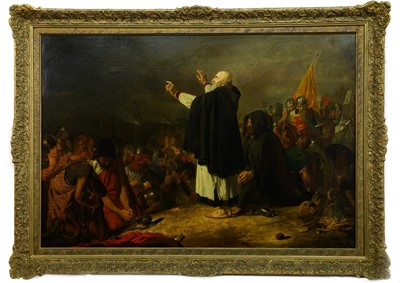15th Mar, 2023 13:00
Scottish Pictures
JAMES DRUMMOND RSA (SCOTTISH 1816 - 1877)
THE ABBOT OF INCHAFFRAY BLESSING THE SCOTTISH ARMY BEFORE THE BATTLE OF BANNOCKBURN
THE ABBOT OF INCHAFFRAY BLESSING THE SCOTTISH ARMY BEFORE THE BATTLE OF BANNOCKBURN
oil on canvas, titled partial label verso
framed
image size 85cm x 125cm, overall size 108cm x 148cm
Partial handwritten exhibition label verso.
Label verso: Britnell's Art Galleries, London & Toronto.
Exhibited: Royal Scottish Academy Annual Exhibition 1844 cat no 173.
Exhibited: Royal Scottish Academy Annual Exhibition 1880 cat no 298 (Lent by Mrs Ballantine)
Note: The Scots soldiery was aroused at around daybreak on Sunday 23rd June 1314. Maurice, the aged blind Abbot of Inchaffray celebrated mass for the army. On seeing this, Edward II is reputed to have said: "Yon folk are kneeling to ask mercy." Sir Ingram de Umfraville, a Balliol supporter fighting for Edward, is said to have replied: "They ask for mercy, but not from you. They ask God for mercy for their sins. I'll tell you something for a fact, that yon men will win all or die. None will flee for fear of death." "So be it", retorted Edward. Robert the Bruce addressed his soldiers, informing them that anyone who did not have the stomach for a fight should leave. A great cry re-assured him that most were ready for the battle. If there is a fact every Scot knows, it is who won the Battle of Bannockburn in 1314; although it did not bring outright victory in the war, which lay 14 years in the future and would only be won at the negotiating table. The victory was a combination of Bruce's demand of 1313: that all of the remaining Balliol supporters acknowledge his kingship or forfeit their estates, and the imminent surrender of the English garrison encircled in Stirling castle – which spurred Edward II to invade Scotland. He mobilised a massive military machine: summoning 2,000 horse and 25,000 infantry from England, Ireland and Wales. Although probably only half the infantry turned up, it was by far the largest English army ever to invade Scotland. The Scots common army numbered around 6000, with a small contingent on horseback. It was divided into three "divisions" or schiltroms (massive spear formations), led by King Robert Bruce, his brother, Edward, and his nephew, Sir Thomas Randolph, Earl of Moray. After eight years of successful guerrilla warfare and plundering the north of England for booty, the Scots had created an experienced battle-hardened army. The battle opened with one of the most celebrated individual contests in Scottish history. Sighting a group of Scots withdrawing into the wood, the English vanguard, made up of heavy cavalry, charged. As they clashed with the Scots, an English knight, Sir Henry de Bohun, spotted Robert Bruce. If de Bohun had killed or captured Bruce, he would have become a chivalric hero. So, spurring his warhorse to the charge, he lowered his lance and bared down on the king. Bruce, an experienced warrior, didn't panic, but mounted "ane palfray, litil and joly" and met the charge. Dodging the lance, he brought his battle axe down on de Bohun's helmet, striking him dead. Elated, the Scots forced the English cavalry to withdraw. The Scots had won the first day. Their morale was high and Bruce's new tactic of using the schiltroms offensively rather than statically, as Wallace had used them at Falkirk, appeared to be working. Yet Bruce must have been contemplating a strategic withdrawal before the set piece battle that would inevitably follow in the morning. For the English the setbacks of the first day were disappointing. Fearing Bruce might mount a night attack, they encamped in the Carse of Balquhiderock. The following day they still hoped to draw Bruce into a full-scale, set-piece battle where their decisive Welsh longbowmen could be brought to bear rather than let Bruce return to guerrilla warfare. At this critical moment, Sir Alexander Seton, a Scots noble in the English army, defected to Bruce bringing him vital intelligence of Edward's army: its confined position and the low morale within the English camp. Bruce decided to risk all in the morning and face Edward in open battle. At dawn the Scots ate their breakfast and advanced out of the wood to face the enemy. Medieval battles were seen as the judgement of God; it was important to have the saints on your side, and so, in the midst of the Scots schiltroms, Abbot Bernard of Arbroath carried their ancient lucky talisman, the Breccbennach (or Monymusk Relquary), which held the relics of St Columba. Bruce himself made a speech invoking the power of St Andrew, John the Baptist and Thomas Beckett. Then, according to the chronicler Walter Bower: "At these words, the hammered horns resounded, and the standards of war were spread out in the golden dawn."
A condition report is offered as an indication of any issues visible to the naked eye. As none of our staff is a professional conservator or restorer, buyers must satisfy themselves in respect of condition and McTear’s can provide contact details of local professionals who can provide fully comprehensive expert reports, usually for a modest charge. The condition report does not form part of any contract between McTear's and the buyer, and all lots are offered "as is" in accordance with our Terms of Business available on our website.
Sold for £3,600
Estimated at £5,000 - £8,000
Request a free auction estimate
Complete the form below and one of our specialists will get back to you.


